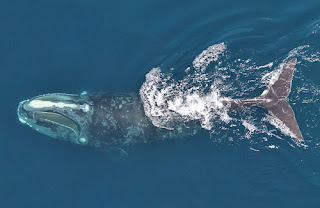 |
| Atlantic Right Whale | photo credit NOAA |
AMAPPS, allows researchers to put all the information about abundance, distribution, ecology and behavior of protected species - from whales, dolphins, and seals to marine turtles and seabirds - into an ecosystem context so resource managers can use it for conservation measures and decision-making.
The primary funders of AMAPPS are NOAA, the Bureau of Ocean Energy Management (BOEM), U.S. Fish and Wildlife Service, and the U.S. Navy. One of the goals of the program is to develop models and related tools to provide distribution patterns and density estimates by season and location that includes habitat characteristics of marine mammals, turtles and seabirds along the U.S. East Coast.
The next five-year program, AMAPPS III, runs from 2019 to 2023. During AMAPPS III, in addition to continuing the above data collection, plankton (in particular larval tuna) samples will be investigated.
As part of AMAPPS activities in 2019, NOAA Fisheries scientists for the Northeast and Southeast Fisheries Science Centers conducted spring aerial surveys covering waters from Florida to Maine from the coastline to more than 200 miles offshore during April 1 to June 30 using NOAA Twin Otter aircraft.
The Northeast Fisheries Science Center also collects oceanographic and environmental data on its own shipboard survey cruises throughout the year, such as the Ecosystem Monitoring survey, which also hosts AMAPPS marine mammal and seabird observers.
One product of the program to date has been the Marine Mammal Model Viewer, which displays the data on a map of the East Coast showing the predicted abundance and distribution of a specific marine species in different seasons of the year, based on the data scientists collected during this project. Sightings of the 17 most common whale, dolphin and porpoise species are included, with more species to be added.
Wind-energy lease areas are marked on the maps, which can be viewed on computers as well as on mobile devices. A user can draw a box around an area of interest, investigate in more detail the density patterns within that box, then download the density data for use in other analyses.
The AMAPPS sightings data have also been used in other density models. For example, they have been used in mammal, turtle, and seabird maps available on the Northeast Ocean Data Portal.
Following the successful AMAPPS project in the western North Atlantic Ocean, similar projects have been initiated in the Gulf of Mexico (GoMMAPPS) and the Pacific Ocean (PacMAPPS).
No comments:
Post a Comment
Please leave your comments about saltwater issues.